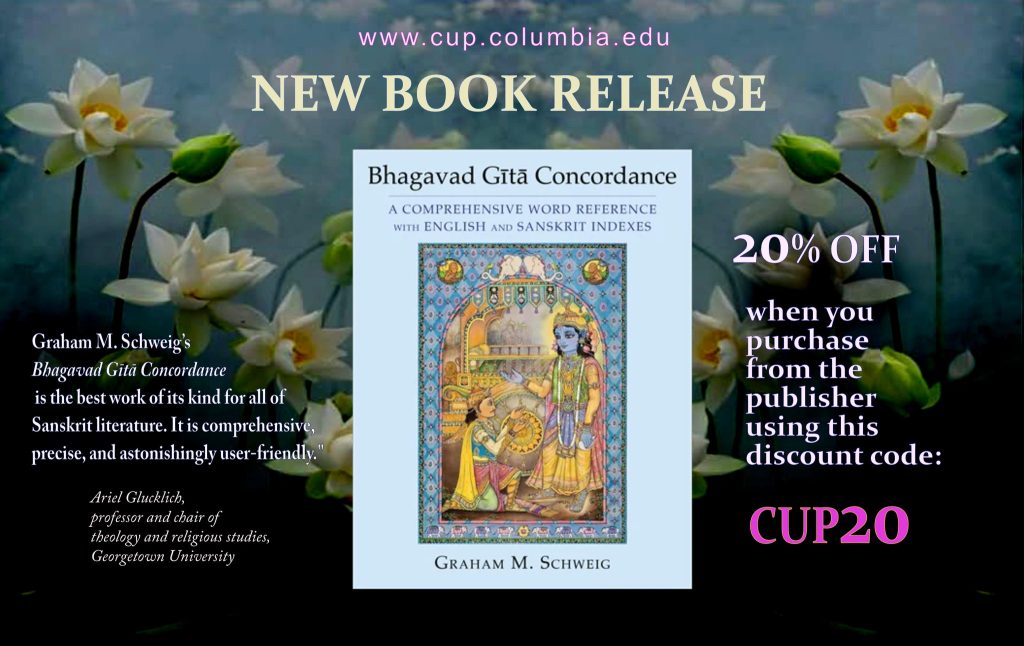First-Ever Comprehensive Concordance for the Bhagavad Gita Released by Columbia University Press
By Thomas Haribol | Feb 08, 2024

The prestigious Columbia University Press has recently released a ground-breaking volume, the first-ever comprehensive concordance of the Bhagavad Gita, authored by Dr. Graham M. Schweig (Garuda Das), PhD.
Entitled “Bhagavad Gita Concordance: A Comprehensive Word Reference with English and Sankrit Indexes,” the new work has been hailed by scholars and students alike as a monumental achievement. It “fills a major lacuna in scholarship and will become a standard reference book and resource for millions of scholars and practitioners,” said Dr. Gopal Gupta of Aurora University in Illinois.
What is a concordance?
A standard concordance provides an alphabetical list of words or terms found in a particular text, accompanied by their respective locations or occurrences within that text. It serves as a helpful tool for researchers, students, or readers to quickly locate specific words or phrases and explore their usage within the given context. It’s most often used to facilitate in-depth study, analysis, or cross-referencing of a particular text.
Given that there are well over a dozen concordances just for the Bible (not to mention many other ancient and modern writings), it is a significant milestone that this kind of resource is finally available for one of the greatest literary and spiritual treasures of the world, the Bhagavad Gita. The Preface notes that while there were some earlier offerings by scholars, “this book is the first truly comprehensive concordance reference work for the Bhagavad Gita that lists every word of the original along with related words as well as Sanskrit and English word indexes.”
A Decades-Long Labor of Love
The reference resource by Dr. Schweig was decades in the making, a labor of love that began on 3×5 cards when he was a graduate student at Harvard University. As technology advanced, his work was transferred to punch cards inserted into massive processors in the 1970s. Later, with the advent of the desktop computer, the project could be expanded and accessed much more quickly. The author and his students used early forms of the concordance over the last few decades, while this final version “evolved and expanded into a much more elaborate and nuanced work,” said Schweig. He expressed his particular thanks to his graduate students, generous donors, and an institution as prestigious as Columbia University for its willingness to publish this beautiful 464-page hardback volume.
An Overview of the Features
The book’s unique features go well beyond what you would find in a typical concordance. Following the Preface, a Brief Overview surveys the various working parts of the reference and offers a Quick Guide, several scenarios for how readers can utilize the work, and a Pronunciation Guide. The Sanskrit Concordance, which is the most extensive section of the book, follows the Sanskrit alphabet, which is helpfully printed in the footer of every page and can be used with many Bhagavad Gitas published today, most notably, Srila Prabhupada’s “Bhagavad-gita As It Is.” This section of the book is followed by the Families of Sanskrit Words feature, which is used in conjunction with the concordance. For example, an arrow next to a word in the concordance indicates that you can find related words in this Families of Sanskrit Words section. Next, you will find the Word Indexes resource, which identifies the key Sanskrit words that carry the essential ideas and themes of the Gita, like bhakti, atman, or dharma. Beneath each transliterated word is the English translation given by four significant editions of the Gita: Srila Prabhupada’s 1972 edition, along with translations by Franklin Edgerton, Laurie L. Patton, and Dr. Schweig. The English-Sanskrit Index is the next section of the reference volume, with each English word identified along with its primary and secondary Sanskrit equivalents. For example, “devotee” is followed by its primary Sanskrit equivalent, “bhakta,” and other words that may also be translated as “devotee,” like “bhaktimat,” “yajin,” and “yogin.” A Transliterated Sanskrit text of the 700 verses follows, and the work concludes with an Outline of 108 Gita Themes and several Appendices.
This brief survey of the reference volume makes it clear that even searchable online databases “cannot produce the kind of results you can find in this volume because the specialist cannot anticipate variations of verbs and their prefixes and noun forms that would be listed far from their original root spellings,” noted Schweig.
Dr. Julius Lipner, professor emeritus of Hinduism and the Comparative Study of Religion at the University of Cambridge, summed up this accomplishment in a recent letter to the author, “It will be one of the most important texts for research in religion and religious culture in general, not to mention Hinduism…Scholarship owes you a great debt of gratitude.” He went on to call the book “the achievement of a lifetime.”
Author Profile
The author, Dr. Graham M. Schweig, PhD, is a professor and director of studies in religion at Christopher Newport University in Virginia, as well as a distinguished teaching and research faculty member at the Center for Dharma Studies at the Graduate Theological Union in Berkeley, California. He earned two master’s degrees and his Ph.D. from Harvard University and is the author of several books, including his translation of the Gita titled “Bhagavad Gita: The Beloved Lord’s Secret Love Song” (2007) and numerous scholarly articles.
He currently has six upcoming books in different stages of pre-publication, including a ground-breaking volume examining the Yoga Sutras of Patanjali through the lens of bhakti to be published by Yale University Press.
Readers interested in learning more about upcoming books, Schweig’s schedule, and more can visit his websites here and here or follow him on Facebook.
The BG Concordance hardback edition can be ordered now on Amazon or as an ebook on Kindle. For a limited time, you can get a 20% discount by visiting the Columbia Press link and where it says “Apply Discount Code +” at checkout, enter CUP20.

Opinions expressed do not necessarily reflect the opinions and beliefs of ISKCON or ISKCON News.


















